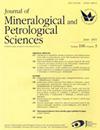A new occurrence of okhotskite in the Kurosegawa belt, Kyushu, Japan: the okhotskite + Mn–lawsonite assemblage as a potential high–pressure indicator
IF 1
4区 地球科学
Q4 MINERALOGY
引用次数: 0
Abstract
We present the fi rst report of okhotskite in a lawsonite – blueschist – subfacies metachert of the Hakoishi subunit, Kurosegawa Belt, Kyushu, Japan, which was metamorphosed at peak temperatures and pressures of 200 – 300 °C and 0.6 – 0.8 GPa. This okhotskite – bearing assemblage is particularly notable because it formed at higher pressures than that of previously documented okhotskite with available pressure estimations. Textural relationships indicate that okhotskite formed during peak metamorphism in equilibrium with piemontite, Na pyroxene, mag-nesioriebeckite, braunite, and hematite. Okhotskite shows a signi fi cant variation in Fe:Mn ratio (Fe tot /Mn tot = 0.13 – 0.56) and a following average empirical formula; (Ca 7.62 Mn 2+0.16 ) Σ 7.78 (Mn 2+2.71 Mg 1.29 ) Σ 4.00 (Mn 3+4.13 Fe 3+2.26 Al 1.36 V 3+0.23 Ti 0.02 ) Σ 8.00 Si 11.86 O 44.02 (OH) 16.98 . Raman spectra of okhotskite are reported for the fi rst time and show characteristic peaks at 362, 480, and 563 cm − 1 . The stability relationships between okhotskite and other Mn – bearing minerals, such as piemontite, sursassite, spessartine, braunite, and Mn – bearing lawsonite, are examined using a revised Schreinemakers ’ analysis. The obtained petrogenetic grid provides tight constraints on the P – T relation-ship of natural mineral assemblages observed in Mn – bearing cherts within epidote – blueschist – grade and lawsonite – blueschist – grade. Furthermore, this petrogenetic grid predicts that the assemblage of okhotskite and Mn – bearing lawsonite should be stable at higher pressures. The higher – pressure stability suggests that highly oxidized Mn – bearing metacherts can transport water and bu ff er oxygen in the deeper parts of subduction zones, given that okhotskite and Mn – bearing lawsonite contain high water contents (6.9 and 11.3 wt% H 2 O, respec-tively) and trivalent manganese.日本九州黑川带一次新发现的鄂霍钛矿:鄂霍钛矿+ Mn-lawsonite组合的潜在高压指示
本文首次报道了在日本九州黑川带白石亚单元中,在200 ~ 300℃、0.6 ~ 0.8 GPa的峰值温度和压力下变质的褐煤-蓝片岩-亚相变质岩中发现的霍霍钛矿。这个含霍霍钛矿的组合特别值得注意,因为它形成的压力比以前记录的有可用压力估计的霍霍钛矿高。构造关系表明,霍霍钛矿形成于与片辉石、钠辉石、镁辉石、褐灰岩和赤铁矿平衡的峰变质过程中。鄂霍茨钛矿Fe:Mn比值变化显著(Fe tot /Mn tot = 0.13 ~ 0.56),平均经验公式如下:(Ca 7.62 Mn 2+0.16) Σ 7.78 (Mn 2+2.71 Mg 1.29) Σ 4.00 (Mn 3+4.13 Fe 3+2.26 Al 1.36 V 3+0.23 Ti 0.02) Σ 8.00 Si 11.86 O 44.02 (OH) 16.98。本文首次报道了霍霍钛矿的拉曼光谱,其特征峰位于362、480和563 cm−1。利用修正后的Schreinemakers分析方法,研究了霍霍钛矿与其他含锰矿物(如片铁矿、苏长石、辉钼矿、白钨矿和含锰lawsonite)之间的稳定性关系。所得的岩石成因网格对绿帘石-蓝片岩品位和褐铁矿-蓝片岩品位含锰燧石中观察到的天然矿物组合的P - T关系有严格的约束。此外,该成因格网预测,在较高的压力下,霍霍钛矿和含锰铁榴辉石的组合应该是稳定的。高压力稳定性表明,高氧化的含锰元岩可以在俯冲带的深层输送水和氧,因为霍霍钛矿和含锰的lawsonite含有高含水量(分别为6.9 wt%和11.3 wt%的h2o)和三价锰。
本文章由计算机程序翻译,如有差异,请以英文原文为准。
求助全文
约1分钟内获得全文
求助全文
来源期刊
CiteScore
1.80
自引率
14.30%
发文量
5
审稿时长
>12 weeks
期刊介绍:
The Journal of Mineralogical and Petrological Sciences (JMPS) publishes original articles, reviews and letters in the fields of mineralogy, petrology, economic geology, geochemistry, planetary materials science, and related scientific fields. As an international journal, we aim to provide worldwide diffusion for the results of research in Japan, as well as to serve as a medium with high impact factor for the global scientific communication
Given the remarkable rate at which publications have been expanding to include several fields, including planetary and earth sciences, materials science, and instrumental analysis technology, the journal aims to encourage and develop a variety of such new interdisciplinary scientific fields, to encourage the wide scope of such new fields to bloom in the future, and to contribute to the rapidly growing international scientific community.
To cope with this emerging scientific environment, in April 2000 the journal''s two parent societies, MSJ* (The Mineralogical Society of Japan) and JAMPEG* (The Japanese Association of Mineralogists, Petrologists and Economic Geologists), combined their respective journals (the Mineralogical Journal and the Journal of Mineralogy, Petrology and Economic Geology). The result of this merger was the Journal of Mineralogical and Petrological Sciences, which has a greatly expanded and enriched scope compared to its predecessors.

 求助内容:
求助内容: 应助结果提醒方式:
应助结果提醒方式:


